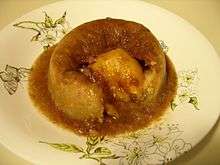Sussex pond pudding
 | |
| Type | Pudding |
|---|---|
| Place of origin | United Kingdom |
| Region or state | Sussex |
| Main ingredients | Suet pastry, lemon, butter, sugar |
| Variations | Ginger Sussex Pond Pudding |
|
| |

Sussex pond pudding is a traditional English pudding from the South East county of Sussex. Made of a suet pastry which encases a whole lemon, with butter and sugar, it is boiled or steamed for several hours. The dish is first recorded in Hannah Woolley's 1672 book, The Queen-Like Closet.
This rich and heavy pudding has gone out of fashion over the years due to health and diet consciousness, although the British chef Heston Blumenthal has served it as part of his campaign to revive historic British foods.[1]
A variant, Currant pond pudding, is known from both Sussex and Kent.[2][3]
Preparation
While cooking, the filling ingredients create a thick, caramelized sauce, which upon serving and cutting of the pudding, runs out and pools around the plate, creating a “pond”. After cooking for so long, the skin of the lemon almost candies like a marmalade in its own juices and that of the butter and sugar.
The most authentic recipes call for beef suet for making the pastry which is available in all supermarkets in the UK, but vegetable shortening, or even cold butter, can be substituted for similar results.
The best lemons to use in this pudding are thin skinned, juicy ones that have not been waxed.
History
The first recorded recipe for the Sussex pond pudding was in Hannah Woolley's The Queen-Like Closet (1672). Woolley suggests encasing a whole apple.[4]
Much older cookery books and recipes do not actually call for use of a lemon at all. Here is one found by Florence White:[5]
”This was given us at Chailey, Sussex, by a nursemaid in 1880 or thereabouts. It was made for me boiled in a cloth (the correct way) in 1905 by an old cottage woman in the village of Westham. In Sussex cottages, steak and kidney puddings are still (1931) boiled in a cloth only.” –H.J. Glover
The first recorded use of a version using a whole lemon was in Jane Grigson's English Food (1974).[4][6]
In her A History of English Food, Clarissa Dickson Wright describes the pudding as requiring "considerable flair to make", as the cook needs to scratch the lemon "so that its flavours burst out while it is being cooked." She notes also that the Sussex shopkeeper Thomas Turner recorded in his diary of the 1750s and 1760s that he ate variants such as currant pond pudding and plum suet pudding.[3]
See also
References
- ↑ Heston Blumenthal (12 November 2013). Historic Heston. Bloomsbury USA. pp. 189–. ISBN 978-1-62040-234-4.
- ↑ The Art and Mystery of Food
- 1 2 Dickson Wright, Clarissa (2011). A History of English Food. London: Random House. pp. 240–241. ISBN 978-1-905-21185-2.
- 1 2 "Sussex Pond Pudding". The Foods of England Project. Retrieved 11 March 2014.
- ↑ Good Things in England, Florence White, First Futura Publications, 1974 Edition
- ↑ Jane Grigson (1 January 1985). Jane Grigson's British Cookery. Atheneum.
Sources
- English Food, Jane Grigson, Penguin Books Ltd, 1998 Edition
- English Puddings, Sweet and Savoury, Mary Norwak, Grub Street Publishing, 2004 Edition
External links
- Sussex Pond Pudding Recipe by James Martin from the BBC.
- Ginger Sussex Pond Pudding Recipe by Allegra McEvedy from The Guardian.